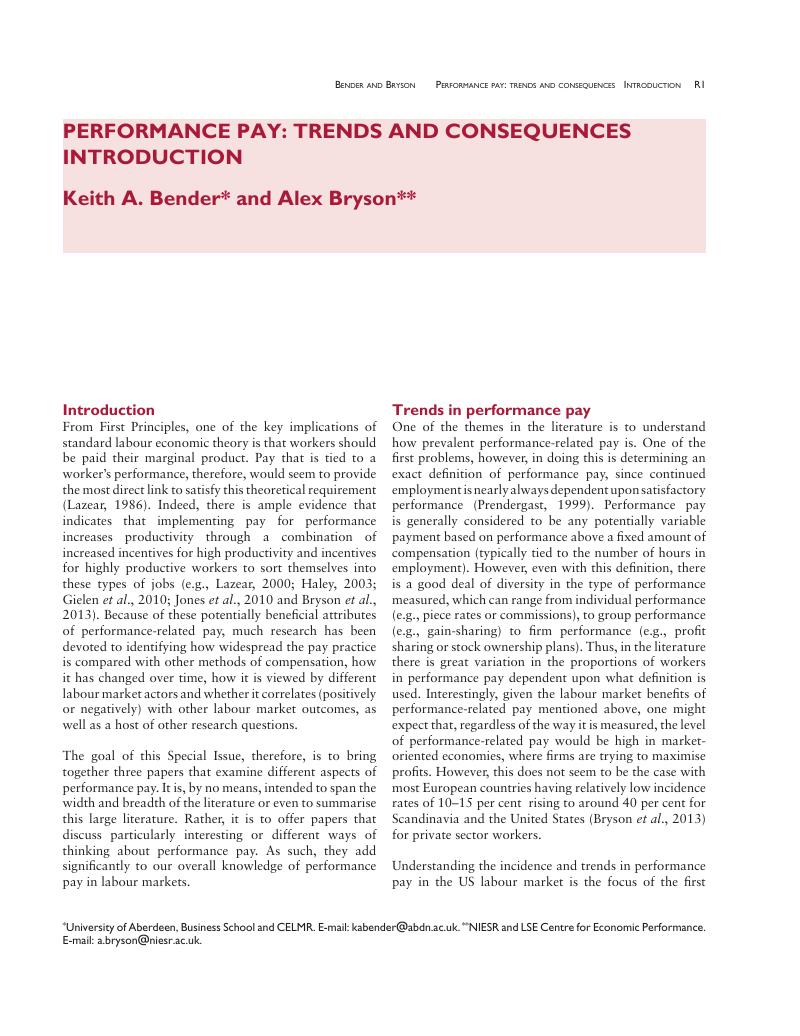No CrossRef data available.
Article contents
Performance Pay: Trends and Consequences Introduction
Published online by Cambridge University Press: 26 March 2020
Abstract
An abstract is not available for this content so a preview has been provided. Please use the Get access link above for information on how to access this content.

- Type
- Research Articles
- Information
- Copyright
- Copyright © 2013 National Institute of Economic and Social Research
References
Bender, K.A.Green, C.P.Heywood, J.S. (2012), ‘Piece rates and workplace injury: does survey evidence support Adam Smith?’, Journal of Population Economics, 25, pp. 569–90.CrossRefGoogle Scholar
Bender, K.A.Theodossiou, I. (2013), ‘The unintended consequences of the rat race: the detrimental effects of performance pay on health’, Oxford Economics Papers (forthcoming).CrossRefGoogle Scholar
Bryson, A.Freeman, R.Lucifora, C.Pellizzari, M.Perotin, V. (2013), ‘Paying for performance: incentive pay schemes and employees’ financial participation’, in Boeri, T., Lucifora, C.Murphy, K.J. (eds), Executive Remuneration and Employee Performance-related Pay: A Transatlantic Perspective, Oxford University Press.Google Scholar
Freeman, R. (1982), ‘Union wage practices and wage dispersion within establishments’, Industrial and Labor Relations Review, 36(1), pp. 3–20.CrossRefGoogle Scholar
Freeman, R.Kleiner, M. (2005), ‘The last American shoe manufactures: decreasing productivity and increasing profits in a shift from piece rates to continuous flow production’, Industrial Relations, 44(2), pp. 307–30.Google Scholar
Gielen, A.C.Kerkhofs, M.J.M.van Ours, J.C. (2010), ‘How performance related pay affects productivity and employment’, Journal of Population Economics, 23(4), pp. 291–301.CrossRefGoogle Scholar
Haley, M.R. (2003), ‘The response of worker effort to piece rates: evidence from the midwest logging industry’, Journal of Human Resources, 38(4), pp. 225–49.Google Scholar
Jones, D.Kalmi, P.Kauhanen, A. (2010), ‘Teams, performance-related pay, profit-sharing and productive efficiency: evidence from a food-processing plant’, Industrial and Labor Relations Review, 63(4), pp. 606–26.CrossRefGoogle Scholar
Lazear, E. (2000), ‘Performance pay and productivity’, American Economic Review, 90, pp. 1346–61.CrossRefGoogle Scholar
Lemieux, T.MacLeod, W.B.Parent, D. (2012), ‘Performance pay and the autocovariance structure of earnings and hours’, mimeo.Google Scholar
MacDonald, G.Marx, L.M. (2001), ‘Adverse specialization’, Journal of Political Economy, 109(4), pp. 864–99.CrossRefGoogle Scholar
Pouliakas, K.Theodossiou, I. (2009), ‘Confronting objections to performance pay: the impact of individual and gain-sharing incentives on job satisfaction’, Scottish Journal of Political Economy, 56(5), pp. 662–84.CrossRefGoogle Scholar
Prendergast, C. (1999), ‘The provision of incentives in firms’, Journal of Economic Literature, 37, 1, pp. 7–63.CrossRefGoogle Scholar




